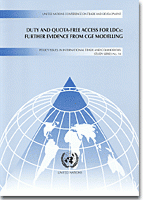
The aim of this work is to assess the effects of trade policy initiatives aimed at improving market access for LDCs in Quad countries (Canada, European Union, Japan and United States).
The study simulates the effects of two policy scenarios:
- Elimination of all tariff and non tariff barriers against LDCs in the European Union. This experiment is aimed at simulating the effects of the already approved EBA initiative.
- Elimination of tariff and non tariff barriers faced by LDCs in all Quad markets. This experiment analyses the effects of a hypothetical coordinated action where the other Quad follow the lead of the European Union.
The policy experiments performed are analogous to those in Ianchovichina, Mattoo and Olarreaga (2000). Results, though, cannot be straightforwardly compared because of several reasons. First, beneficiary countries in our case are all LDCs, whereas in Ianchovichina, Mattoo and Olarreaga (2000) preferential market access is targeted to Sub-Saharan African countries only. Second, our analysis is conducted at a higher level of disaggregation, both sectoral and geographical. Finally, data in our simulations refer to 1997, whereas in Ianchovichina, Mattoo and Olarreaga (2000) the base year is 1995 (GTAP4 database).
Results show that non-reciprocal preferential trade liberalization targeted to LDCs is likely to entail non-negligible gains to beneficiary countries coupled with negligible losses for donor and third countries. When the only donor country is the European Union (EBA initiative), the gains accrue mainly to Sub-Saharan African countries, and are mostly explained by improved terms of trade for beneficiaries. In this case, the key sectors are paddy and processed rice, and sugar. Increased exports from LDCs are directed almost only to the European Union. When liberalization occurs in all Quad countries, the benefits from duty-free and quota-free market access rise substantially. Overall, welfare gains are ten times higher compared with EBA. All beneficiary countries gain notably more, and countries like Bangladesh and the rest of Sub-Saharan Africa enjoy disproportionately higher gains. In this case, in addition to rice and sugar, key sectors to benefit are wearing apparel, other food and diary products. Increased export flows from some LDCs are still mainly directed to the European Union under this scenario. For other beneficiary countries, however, the rise in exports is basically targeted to the United States market (Bangladesh), and to Japan (rest of Sub-Saharan Africa).


